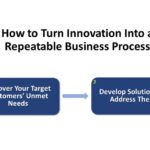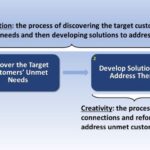Putting Jobs-to-be-Done into Action
Some of you may remember that I shared a video a few months ago from which the still shot above was taken. “Squat University,” an online strength-building fitness company, used the video to demonstrate why “strength training is something we should do for the rest of our lives. It allows us to live the life we want.”
I encourage you to watch it again or for the first time (2 minutes). It’s more than a masterfully done mini-drama. It also provides a good illustration of how you can put the jobs-to-be-done (JTBD) innovation approach into action for marketing and creating new and improved offerings.
JTBD is built upon the insight that people “hire” products and services to get their jobs done. People hire Squat University to help them build strength and thereby live the life they want. “Strength training to live the life you want” strikes me as an excellent high-level marketing message that resonates well, especially with people as they age. (There’s actually a classification of training called “functional fitness” that helps people execute real-life movements and activities).
But, while the job “live the life you want” may be effective as a high-level message for marketing, it’s too abstract to help a health and fitness business owner create new or improved offerings. To do that, they must identify the specific functional, emotional, and social jobs that people are trying to get done to live the life they want. Building strength is just one job among many health and fitness objectives that people want to accomplish in order to live the life they want.
In my own work with a health and fitness entrepreneur a couple of years ago, we identified 29 functional jobs that people hire gyms to get done to improve their health and fitness and live the life they want, such as:
- Lose weight
- Build cardio fitness, e.g., stamina, endurance, etc.
- Build flexibility
We also identified two dozen emotional jobs that people hire gyms to experience, such as:
- Feel attractive
- Feel proud of my body
- Feel strong/healthy/fit
And social jobs to be done with a gym:
- Be perceived as knowledgeable/competent about working out, e.g., how to use the machines, how to achieve results, etc.
- Be perceived as disciplined
- Be perceived as attractive
Notice that none of these job (need) statements suggests how they will be accomplished. That’s up to the solution provider to figure out after gaining clarity about what customers are trying to accomplish. People don’t care about your offerings or mine; they just want to get their jobs done. Identifying the customers’ true needs separate and distinct from solutions is essential for successful innovation because it ensures you won’t be constrained by current products/services. This increases the likelihood of breakthrough innovation.
Although identifying the jobs that your customers are trying to get done is very helpful, it may not be enough. That’s because only important unsatisfied jobs (needs) are opportunities for innovation and growth. Distinguishing which jobs are important and unsatisfied can be challenging if you’re only doing qualitative research.
The most effective way to identify and rank the opportunities in your market is by deploying a survey to a representative sample of your target customers so they can rate each need statement for how important it is to get it done and how satisfied they are with their ability to get it done given their current product/service solution. This makes it possible to mathematically identify and rank those needs that are both important and unsatisfied – i.e., opportunities – with statistical validity. The more important and less satisfied a need is, the greater the opportunity for innovation and growth it presents.
Once you have identified and ranked the opportunities in the market, the next step is to select which opportunities to pursue for new value creation. That means evaluating each opportunity for its attractiveness based on a number of factors you choose, such as the revenue opportunity, feasibility, strategic fit, etc. Great growth strategies and new products address known market needs with the firm’s relative strengths, so that’s what we’re doing here in a systematic fashion. Keep in mind that, for the purpose of innovation, we define a “market” as “a group of people and the shared job or jobs they want to get done,” so every important unsatisfied job is a potential new market opportunity. This is a great way to find new market opportunities and generate new revenue streams.
And while you’re evaluating which markets you want to pursue (i.e., which jobs you want to help customers get done better), you can also determine how you will win in each market at a strategic level. Most opportunities are best addressed by building new or improved offerings, but some are better addresses with a merger/acquisition, joint venture, partnership, through operational innovation, or simply with better messaging and positioning. Knowing this before you generate ideas enables companies to forge organization/market fit before attempting to forge product/market fit. This further increases the likelihood of success.
Lastly, for those market opportunities that you want to address with new or improved offerings, devise solution ideas that address the selected opportunities. At this point in the process, because you have already validated the market and selected those opportunities that are most attractive to pursue, you can generate ideas with great clarity and confidence about where to focus and what to do to create unique value for your target customers. Knowing where to focus your creativity makes all the difference in the world
Every organization that survived and/or thrived through the COVID lock downs figured out new ways to help their target customers get their jobs done within the new constraints. (This is where gaining an understanding about the customers’ criteria for success in the new reality becomes essential – a topic for another post). Products and services come and go but the jobs people want to get done remain remarkable stable over time. JTBD is a recipe for creating new value in any environment.
Reveal needs. Create value. Drive growth.




